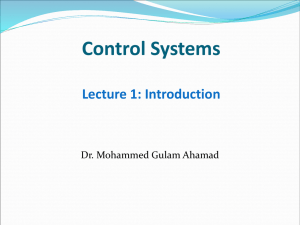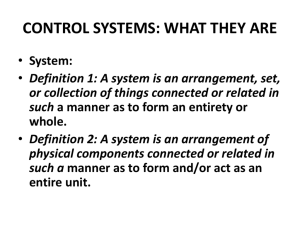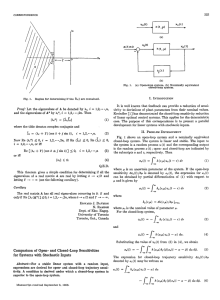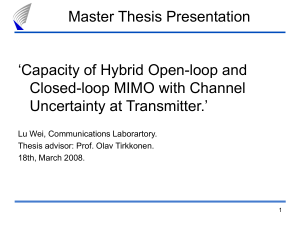S. Boyd EE102
advertisement
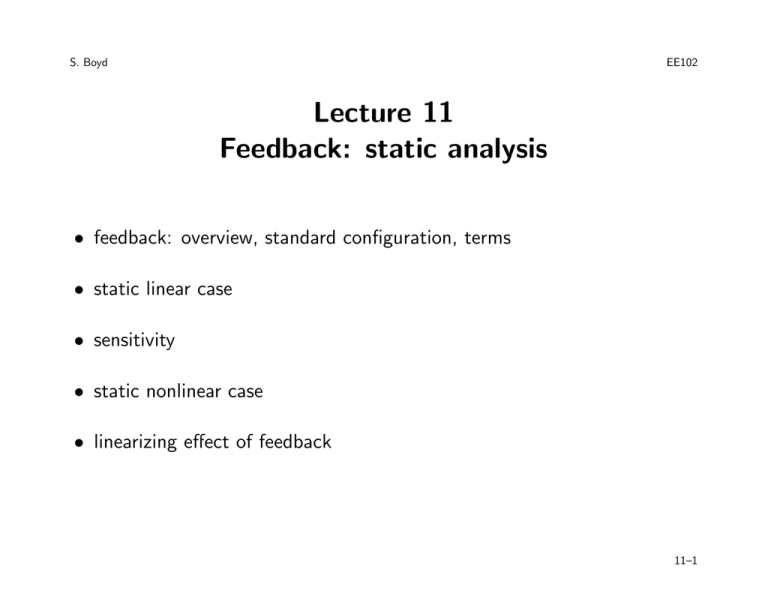
S. Boyd EE102 Lecture 11 Feedback: static analysis • feedback: overview, standard configuration, terms • static linear case • sensitivity • static nonlinear case • linearizing effect of feedback 11–1 Feedback: general a portion of the output signal is ‘fed back’ to the input standard block diagram: PSfrag replacements u e A y F • u is the input signal; y is the output signal; e is called the error signal • A is called the forward or open-loop system or plant • F is called the feedback system in equations: y = Ae, e = u − F y Feedback: static analysis 11–2 • feedback ‘loop’: e affects y, which affects e . . . • overall system is called closed-loop system • signals can be analog electrical (voltages, currents), mechanical, digital electrical, . . . • the − sign is a tradition only feedback is very widely used • in amplifiers • in automatic control (flight control, hard disk & CD player mechanics) • in communications (oscillators, phase-lock loop) Feedback: static analysis 11–3 when properly designed, feedback systems are • less sensitive to component variation • less sensitive to some interferences and noises • more linear • faster (when compared to similar open-loop systems) we will also see some disadvantages, e.g. • smaller gain • possibility of instability Feedback: static analysis 11–4 Other feedback configurations we will also see other feedback configurations, e.g. PSfrag replacements r e C u P y which is often used in automatic control for now we stick to the ‘standard configuration’ (p.11–2) Feedback: static analysis 11–5 sometimes the ‘feedback loop’ is not clear (e.g., in amplifier circuits) VDD PSfrag replacements Rl Vout Id D G S Vin Rs here we have Vout = Rlf (VGS ), VGS = Vin − (Rs/Rl)Vout, where Id = f (VGS ) Feedback: static analysis 11–6 Static linear case static case: signals do not vary with time, i.e., signals u, e, y are (constant) real numbers (dynamic analysis of feedback is very important — we’ll do it later) suppose forward and feedback systems are linear, i.e., A and F are numbers (‘gains’) eliminate e from y = Ae, e = u − F y to get y = Gu where A G= 1 + AF is called the closed-loop system gain (A is called open-loop system gain) L = AF is called the loop gain — it is the gain around the feedback loop, cut at the summing junction Feedback: static analysis 11–7 observation: if L = AF is large (positive or negative!) then G ≈ 1/F and is relatively independent of A how close is G to 1/F ? 1 1/F − G = (after some algebra) consider relative error : 1/F 1 + AF 1 1 = S= 1 + AF 1+L is called the sensitivity (and will come up many times) for large loop gain, sensitivity ≈ 1/loop gain thus: for 20dB loop gain, G ≈ 1/F within about 10% for 40dB loop gain, G ≈ 1/F within about 1% etc. Feedback: static analysis 11–8 Example: feedback amplifier PSfrag replacements Av v vout vin R1 R2 described by: vout = Av, v = vin − (R1/(R1 + R2))vout • vin is the input u; vout is the output y • v is the ‘error signal’ e • open-loop gain is A • feedback gain is F = R1/(R1 + R2) vout = Gvin, where closed-loop gain is G = Feedback: static analysis A 1 + AF 11–9 example: for F = 0.1 and A ≥ 100, G ≈ 10 within 10% as A varies from, say, 100 to 1000 (20dB variation), G varies about 10% (around 1dB variation) in this example, large variations in open-loop gain lead to much smaller variations in closed-loop gain Feedback: static analysis 11–10 Sensitivity to small changes in A how do small changes in the open-loop gain A affect closed-loop gain G? ∂ 1 ∂G A = = ∂A ∂A 1 + AF (1 + AF )2 so for small change δA, we have 1 δA δG ≈ (1 + AF )2 express in terms of relative or fractional gain changes: 1 (δA/A) = S(δA/A) (δG/G) ≈ 1 + AF hence the name ‘sensitivity’ for S Feedback: static analysis 11–11 for small fractional changes in open-loop gain, S≈ fractional change in closed-loop gain fractional change in open-loop gain (so ‘sensitivity ratio’ is perhaps a better term for S) for large loop gain (positive or negative), |S| ¿ 1, so small fractional changes in A yield much smaller fractional changes in G: feedback has reduced the sensitivity of the gain G w.r.t. changes in the gain A Feedback: static analysis 11–12 we can relate (small) relative changes to changes in dB: 20 20 δ log X ≈ (δX/X) δ(20 log10 X) = log 10 log 10 (20/ log 10 ≈ 9, i.e., 10% relative change ≈ 0.9dB) hence we have (for small changes in A), δ(20 log10 G) ≈ S δ(20 log10 A) thus (for small changes in open-loop gain), dB change in closed-loop gain S≈ dB change in open-loop gain Example: ±2dB variation in A, with L ≈ 10, yields approximately ±0.2dB variation in G Feedback: static analysis 11–13 Summary: for loop gain |L| À 1, • gain is reduced by about |L| • sensitivity of gain w.r.t. A is reduced by about |L| thus, feedback allows us to trade gain for reduced sensitivity e.g., convert amplifier with gain 30 ± 2dB to one with gain 20 ± 0.7dB or 10 ± 0.2dB Feedback: static analysis 11–14 Remarks: • feedback critical with vacuum tube amplifiers (gains varied substantially with age . . . ) • get benefits for ‘negative’ (AF > 0) or ‘positive’ (AF < 0) feedback — makes little difference in static case • sensitivity w.r.t. F is not small — need accurate, reliable feedback components • can also trade sensitivity for more gain, by setting AF ≈ −1 Feedback: static analysis 11–15 Nonlinear static feedback We suppose now that the forward system is nonlinear static, i.e., A is a function from R into R, e.g., 1.5 1 A(e) y 0.5 0 −0.5 PSfrag replacements −1 −1.5 −0.1 −0.05 0 e 0.05 0.1 0.15 very common for amplifiers, transducers, etc. to be at least a bit nonlinear A is called the nonlinear transfer characteristic of the forward system (never to be confused with transfer function!) Feedback: static analysis 11–16 we’ll keep the feedback system F linear for now PSfrag replacements u e A(·) y F feedback system is described by y = A(e), e = u − F y these are coupled nonlinear equations: • maybe multiple solutions; maybe no solutions • usually impossible to solve analytically • can be solved graphically, or by computer usually for each u ∈ R there is one solution y, so we can express the closed-loop transfer characteristic as a function: y = G(u) Feedback: static analysis 11–17 Example: open-loop characteristic A: 1.5 1 A(e) y 0.5 0 −0.5 PSfrag replacements −1 −1.5 Feedback: static analysis −0.1 −0.05 0 e 0.05 0.1 0.15 11–18 with feedback gain F = 0.2, yields closed-loop characteristic 1.5 1 y 0.5 G(u) 0 −0.5 PSfrag replacements −1 −1.5 −0.6 −0.4 −0.2 0 u 0.2 0.4 0.6 (you should check a few points!) Feedback: static analysis 11–19 Observations: with feedback • ‘gain’ is lower (note different horizontal scales) • characteristic is more linear (for |y| < 1) these phenomena are general . . . closed-loop transfer characteristic function G satisfies G(u) = y = A(e), e = u − F G(u) differentiate w.r.t. u: de G (u) = A (e) , du 0 Feedback: static analysis 0 de = 1 − F G0(u) du 11–20 eliminate de/du to get A0(e) G (u) = 1 + A0(e)F 0 conclusions: for u s.t. |A0F | À 1, • G0 ≈ 1/F (independent of u) i.e., G is nearly linear! • slope of G is smaller than slope of A (by factor 1 + A0F ) Feedback: static analysis 11–21 A measure of nonlinear distortion let w = H(v) be a nonlinear I/O characteristic assume H(0) = 0 and look at Taylor series 1 H(v) = H 0(0)v + H 00(0)v 2 + · · · 2 ratio of quadratic term to first order term is H 00(0) v, 0 2H (0) so H 00(0)/H 0(0) gives a measure of distortion (for a given input v, or a given output w) now consider feedback system, with A(0) = 0 distortion measure for open-loop system is A00(0)/A0(0) Feedback: static analysis 11–22 differentiate G0 = A0/(1 + A0F ) w.r.t. u to get A00(e) G (u) = (1 + A0(e)F )2 00 distortion measure for closed-loop system is G00(0)/G0(0) = 1 00 0 A (0)/A (0) 0 1 + A (0)F thus, nonlinear distortion measure is reduced by the sensitivity S of the linearized system! Feedback: static analysis 11–23 Finding the closed-loop characteristic Graphical method (load line): write feedback equations as y = A(e), e = u − Fy for given u sketch both equations on e-y plane; intersection gives solution y e = u − Fy PSfrag replacements y = A(e) y = G(u) e slope = −1/F u easy to visualize what happens as u or F changes Feedback: static analysis 11–24 Newton’s method to solve y = A(e), e = u − F y (given A, u, and F ) 1. guess a value e0 for e; set k = 0 2. set yk := A(ek ) 3. if ek = u − F yk , quit 4. replace nonlinear equation y = A(e) with first-order Taylor expansion near ek , y ≈ A(ek ) + A0(ek )(e − ek ) Then solve the linear equations ŷ = A(ek ) + A0(ek )(ê − ek ), ê = u − F ŷ for ê and ŷ; set ek+1 := ê u − F yk + F A0(ek )ek I.e., set ek+1 := 1 + F A0(ek ) 5. k := k + 1; go to 2 Feedback: static analysis 11–25 works very well when initial guess is good; may not converge for bad initial guess Feedback: static analysis 11–26 Graphical interpretation of Newton’s method y y = A(ek ) + A0(ek )(e − ek ) y = A(e) e = u − Fy e PSfrag replacements ek ek+1 Feedback: static analysis 11–27 Tracing the closed-loop characteristic curve write feedback equations as y = A(e), u = e + Fy given error e, we can easily find associated y and u! can use this to trace the curve, parametrized by e: 1. choose e1, e2, . . . , en that cover an appropriate range for e 2. for i = 1 to n, set yi := A(ei), ui := ei + F yi 3. plot (u1, y1), . . . , (un, yn) note that here we don’t specify the u values (as in Newton’s method) Feedback: static analysis 11–28 Example: JFET amplifier (we assume vGS ≤ 0) VDD PSfrag replacements Rl vout Id D G S vin Rs can express as static nonlinear feedback system: vout = A(vGS ), vGS = vin − F vout, with F = Rs/Rl and ½ RlIDSS (1 − vGS /VP )2 VP ≤ vGS ≤ 0 A(vGS ) = 0 vGS < VP Feedback: static analysis 11–29 we’ll take Rl = 10kΩ, IDSS = 1mA, VP = −2V 10 9 8 7 vout R6s = 0Ω PSfrag replacements Rs = 5kΩ 5 4 3 2 1 0 −2 −1 0 1 2 3 4 5 vin plot shows vout vs. vin for Rs = 0, 1, . . . , 5kΩ (corresponds to F = 0, 0.1, . . . , 0.5) as feedback increases, closed-loop ‘gain’ is smaller; closed-loop characteristic is more linear Feedback: static analysis 11–30 Summary • using feedback we can trade raw gain for lower sensitivity, greater linearity • benefits determined by S = 1/(1 + AF ): sensitivity and nonlinearity are both reduced by S • large loop gain L = AF (positive or negative) yields small S hence benefits of feedback Feedback: static analysis 11–31
